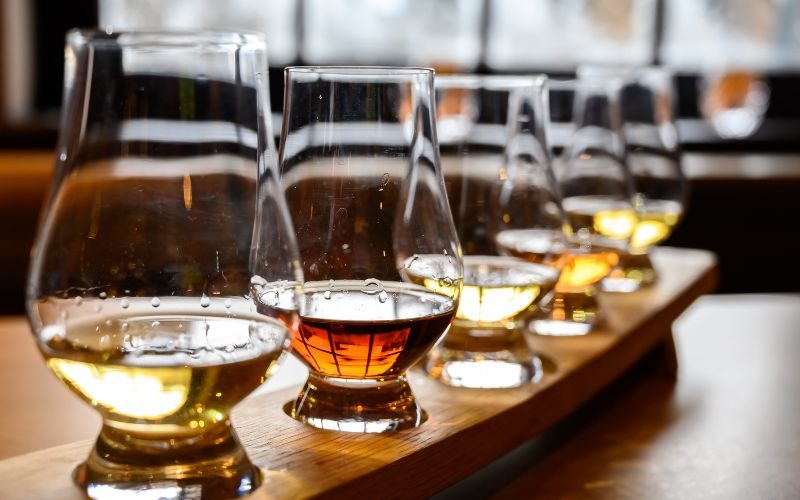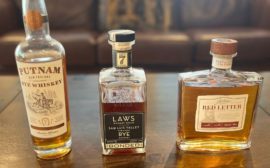Recognizing certain flavors in whiskey is essential to a whiskey tasting experience. Identifying these flavors in a blind tasting while crossing categories (i.e., Scotch, Bourbon, Irish, etc.) is a fun and educational way to discover your favorite flavor profile and product category.
This article intends to highlight flavors typically found in the most prominent whiskey categories and identify where these come from (barrel vs. spirit).
Flavors in Bourbon
The sweet aroma and flavor of the spirit are hard to miss. Flavors of sugar, cinnamon, and corn from the new make spirit are typical. The barrel provides a caramel, coconut, vanilla, smoke, leather, and spicy flavors.
In this category the flavors from the barrel have an advantage over the flavors imparted by the corn. The distillery must decide the char level (1-4) for its barrels to give the bourbon its personality.
For example, a light char (Level 1- 15 seconds) will impart spicy and earthy flavors from the oak to the new make spirit, while a heavy char (Level 4 = 55 seconds) will impart a darker color and a sweet and smoke flavor. Char levels 2 (30 seconds) and 3 (35 seconds) will impart the flavors of caramel, vanilla, and toffee notes to the new make spirit.
The distillery selects the appropriate yeast strain for fermentation, the duration in days of the fermentation process, the distillation method (i.e., Column, Pot Still, Hybrid), and char level to create the desired flavor profile.
A few suggestions:
- Heaven Hill Bottled in Bond
- Buffalo Trace
- Old Weller Antique 107
Flavors in Scotch Whisky
In this category, aromas and flavors of cereal (malt), smoke, peat, citrus, and spice from the new make spirit are classic. These flavors are derived mainly from the malting process of the grain (i.e., barley) and fermentation. Applying peat to malt (roast) the barley is a decision the distillery must make to create the desired flavor profile.
Flavors of coconut, dried fruits, red wine, oak, and vanilla are associated with barrel aging. Unlike their American counterparts, Scots can use oak barrels that previously held a bourbon to impart flavors of vanilla and coconut. The use of barrels that previously held sherry is also frequent in the Scotch industry to impart flavors of dried fruits to the whisky.
In this category the sharp flavors of the peated spirit have an advantage compared to the flavors imparted by the barrel (at least in the first ten years), but in a Scotch Whisky aged in ex-sherry casks, the cask has the advantage: French oak and Virgin oak impart tannic and vanilla flavors to the new make spirit very quickly. Therefore, Scotch Whisky is rarely fully matured in these casks, primarily used to finish the whisky for a short period (three months to one year).
A few suggestions:
- Glendronach 15-Year-Old Revival
- Bruichladdich Classic Laddie (Scottish Barley)
- The Glenlivet French Oak 15-Year-Old
Check our Scotch whisky reviews
Flavors in Irish Whiskey
In this category, aromas and flavors of fruits (green apples, pineapple, lemon, etc.) and herbal notes are staples. The fact that the Irish produce Pot Still Whiskey from a mash of malted and unmalted barley for extra sweetness is a game-changer.
Flavors of coconut, vanilla, and dried fruits are typical of barrel aging in this category. However, aging in Mizunara oak and wine (red and white) has become popular in recent years.
The light fruit notes from the spirit have the advantage. Ideal for new fans of a refreshing style of whiskey. The use of wood of any kind for aging gives the category enough room to innovate and create very different flavor profiles.
A few suggestions:
- Yellow Spot Irish Pot Still Whisky
- Green Spot Château Léoville Barton
- Bushmills Black Bush
Check our Irish whisky reviews
Flavors in Japanese Whisky
Many Japanese whiskies have a clear wort and long fermentations, allowing the growth of lactic acid bacteria, creating fruity organic compounds known as Esters. Flavors derived from the barrel are typical of bourbon or sherry casks with vanilla, oak, and spices. In this category, spirit and casks have equal influence on the final whisky.
A few suggestions:
- Hakushu 12 Yeard-Old
- Hibiki Harmony Master’s Select
- Shinobu 10-Year-Old Pure Malt Whisky
Check our Japanese whisky reviews
Flavors in Canadian Whisky
Canadian whiskies can have a sweet taste followed by spicy flavors of pepper and ginger from the rye. From an aging perspective, the barrels provide vanilla, oak, and caramel flavors. In this category, the rye typically prevails over the barrel, as it is the signature trait of Canadian Whisky.
A few suggestions:
- Lot 40 Canadian Rye
- J.P. Wiser’s Legacy
- Alberta Rye Dark Batch
I hope you enjoyed this short note on the five main whisky categories. Let me know your thoughts about your favorite whiskies in these categories. Cheers!





